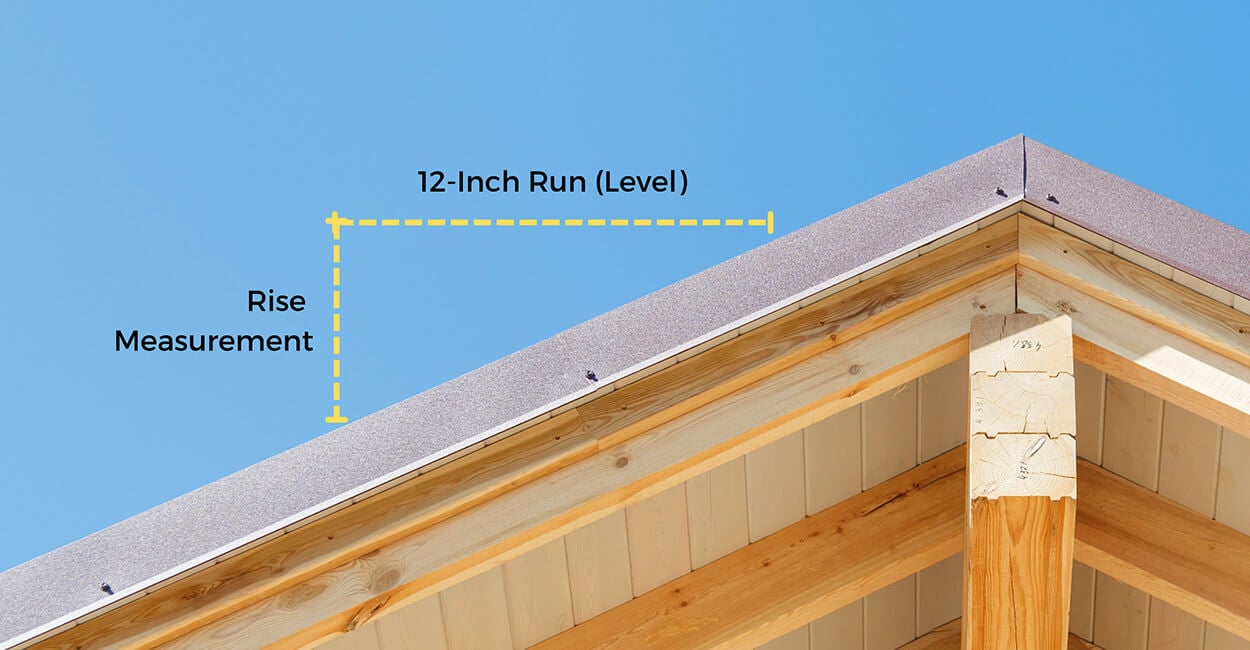Roof pitch refers to the angle or slope of a roof. In most cases, all you’ll need to measure it is a spirit level, a ruler or speed square, and a sturdy step ladder to access the roof safely.
Measuring the pitch involves two key values: the rise, which is the vertical height of the roof, and the run, which is the horizontal distance it covers. Together, these measurements determine the roof’s angle.
Importantly, there are safer ways of measuring your roof's run without having to line up a tape measure along the total horizontal distance on the outside of a building. And the same goes for the vertical distance from the apex of the roof to the base. We outline four methods for safely measuring roof pitch, whether you are on top of a roof undergoing maintenance or repairs, or find yourself inside the attic next to the rafters.
If you’re wondering how to accurately measure your roof pitch, it’s easier than you might think. In the steps below, we’ll show you how to quickly work out your roof’s angle, convert it into a ratio, and even use a few handy smartphone apps to make the job simpler.
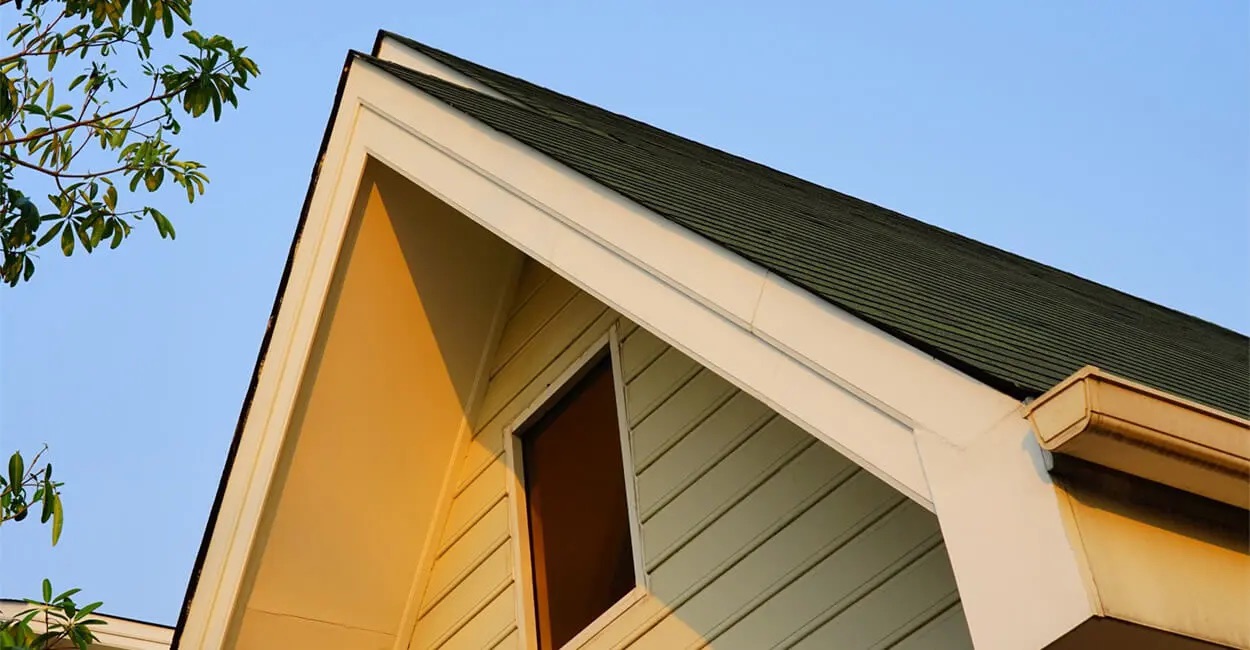

Why does roof pitch matter?
The roof pitch angle of a roof is an important factor when choosing your next roof covering. Different materials require a minimum recommended pitch to perform effectively, and installing them outside of these guidelines can compromise both the stability and lifespan of your roof.
For flat roofs, which have a roof pitch ranging from 0-10°, it's important to choose the correct roofing materials that won't be affected by standing water or debris.
Roof pitch doesn’t just determine which materials you can use — it also affects the profile of steel pitched roofs. If you’re starting from scratch, this could influence the overall design of your project. On existing buildings, it may alter the final appearance of the roof once complete.
The formula for roof pitch
Simply put, a roof pitch is the slope, or angle, of a roof. The steeper the roof, the higher its pitch. A roof with a small slope, or a flat roof, will have a smaller total rise (the vertical distance from the base of the roof to the apex, or ridge top plate). A sloped roof with a greater total width and rise will, in turn, have a longer rafter length and will require more materials.
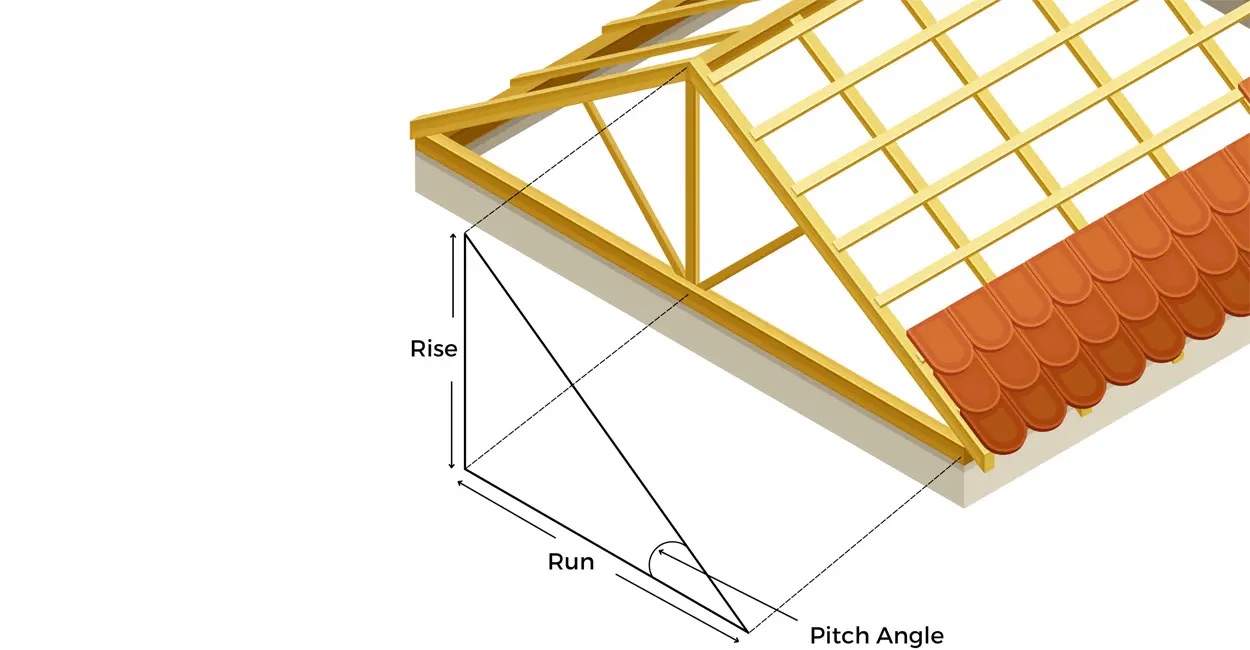

If you already know the values of the rise and run, you can calculate the roof pitch using the formula below. In practice, though, working out both measurements can be tricky due to access and safety concerns. If that’s the case, don’t worry, there are easier ways to measure the roof pitch using simple tools like a speed square or even with the help of a smartphone app.
Use the following formula to calculate the pitch and express your roof angle as a ratio:
Step 1 - Roof pitch as a decimal
To calculate the roof pitch as a ratio, you first need to calculate the roof pitch as a decimal. This can then be multiplied by 12. Follow the basic formula below:
Pitch decimal = the rise divided by run
Start by measuring the total rise and run measurements using a tape measure. Let's say, for example, the rise is 3 metres and the run is 5 metres. The formula would be:
3 ÷ 5 (rise ÷ run) = 0.6 (pitch decimal)
Step 2 - Roof pitch decimal to ratio conversion
Your roof pitch, when shown as a ratio, compares the vertical rise to a standard 12-inch horizontal run. To work this out, simply multiply the pitch decimal by 12. For example, using the calculation above:
0.6 (pitch decimal) x 12 = 7.2
So the roof pitch shown as a ratio using the above example measurements is 7.2:12.
Use the conversion chart below to convert the pitch ratio to an angle.
How to easily measure rise and run
1) Take measurements at the gable end
One of the simplest ways to calculate your roof pitch ratio is from the gable end of the building, using the same rafter against the wall. With a spirit level and a speed square, you can measure this safely and accurately.
From the roof surface, measure 12 inches in towards the eaves and use the spirit level to create a horizontal line. Then, place the speed square vertically to record the rise, the point where it meets the spirit level will give you your measurement.
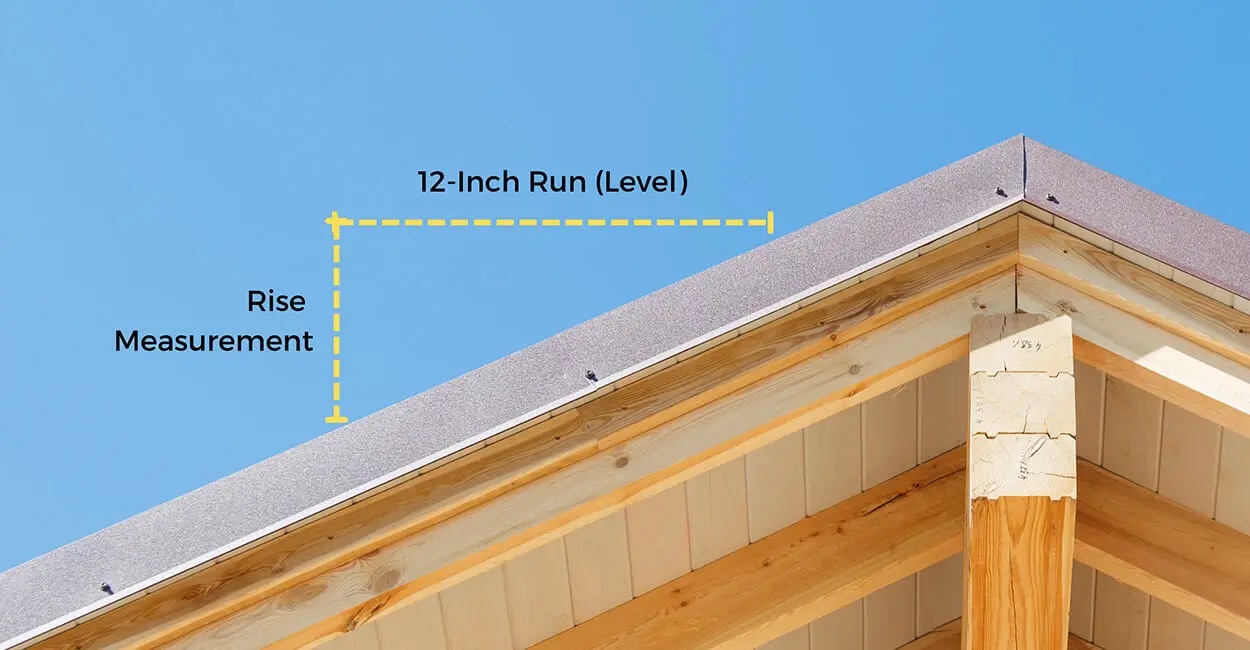

Once you have the rise measurement, for example 5 inches, this will give you the standard pitch as a ratio, so this would be 5:12.
2) Take measurements on the roof
If you are on a roof and are looking to calculate the pitch, you can use a couple of easy methods to make sure you get a roof pitch measurement. Similar to the above method, use a spirit level and ruler to measure 12 inches from the surface of the roof outwards to the eaves. Make a mark on your spirit level and, using a ruler, measure down from the 12-inch mark until you reach the roof surface.
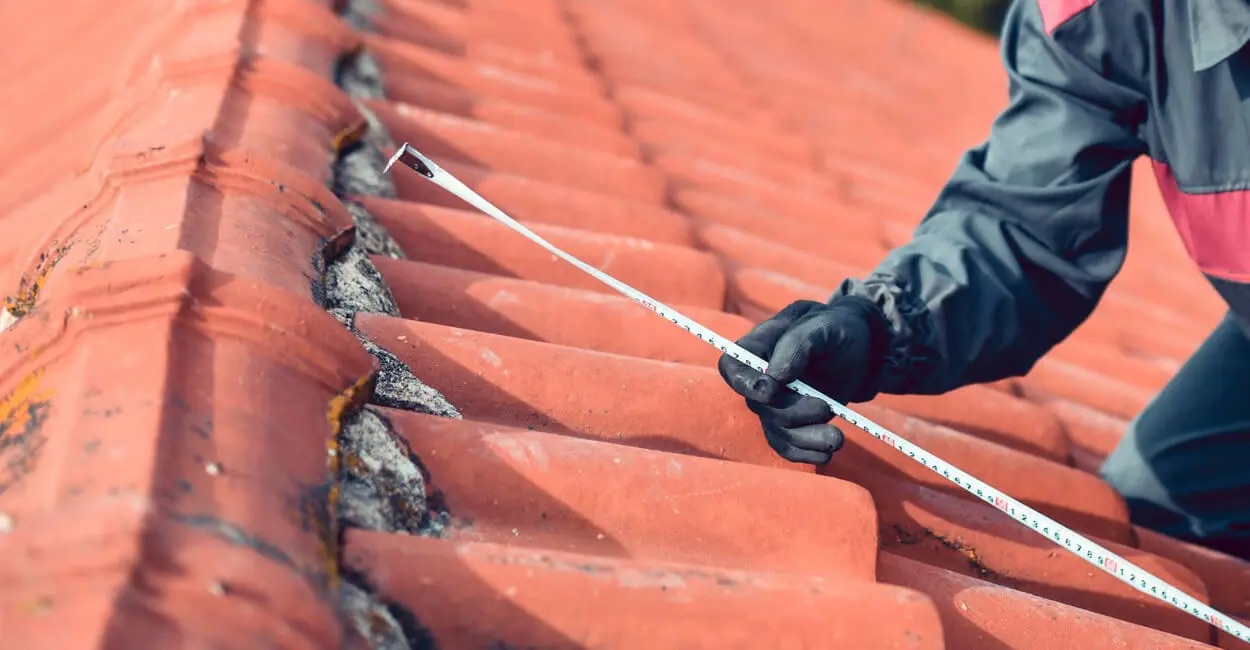

Instead of marking two lines with a spirit level and speed square, you could also use an app to calculate the slope angle in degrees and quickly assess the rise and run — we’ll cover some suitable options later in this article.
3) Take measurements from the attic room
To measure the roof pitch from inside an attic room, where you are underneath the roof, you will need to use a spirit level and a tape measure. Butt your spirit level next to the underside of your roof sheathing, or rafter, and then measure out 12 inches of horizontal distance along a level plane. From the 12-inch mark, measure upwards to the roof rafters and note the measurement to get the rise figure in inches.
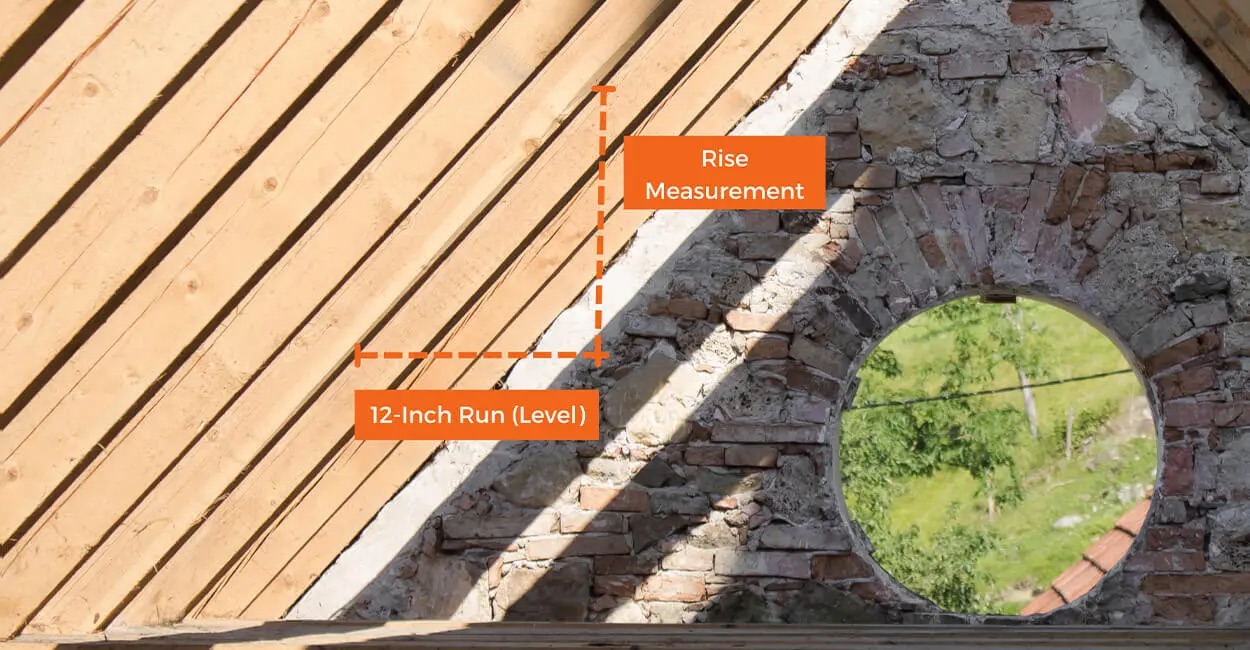

This will give you the rise of the roof, for example, 9 inches, so the roof pitch in this case will be 9:12.
What is a roof pitch ratio?
A roof’s pitch is often expressed as a ratio, showing how many inches the roof rises vertically for every 12 inches of horizontal run. Roof pitch can also be measured as an angle in degrees.
For example, a ratio of 2:12 means the roof rises 2 inches for every 12 inches of run, which is a common measurement for low-pitched roofs. Use the chart below to convert pitch ratios into angles in degrees.
Calculating roof pitch ratio
A roof pitch ratio is calculated by comparing the rise to the run. Standard practice is to measure the rise over a 12-inch run. To do this, place a spirit level against the roof sheathing and mark 12 inches along the level plane. From that point, measure vertically up to the roof using a ruler or square. This figure is your rise, and together with the 12-inch run, it gives you the roof pitch ratio.
Roof pitch conversion chart
| Pitch Ratio | Angle |
|---|---|
| 1:12 | 4.76 |
| 2:12 | 9.46 |
| 3:12 | 14.04 |
| 4:12 | 18.43 |
| 5:12 | 22.62 |
| 6:12 | 26.57 |
| 7:12 | 30.26 |
| 8:12 | 33.69 |
| 9:12 | 36.87 |
| 10:12 | 39.81 |
| 11:12 | 42.51 |
| 12:12 | 45.00 |
Roof pitch calculator apps
If you don’t have a tape measure or spirit level to hand, there are plenty of useful apps that you can download to help you measure the roof pitch quickly and accurately. Installing a roof slope calculator on your smartphone can save time and effort when working out the rise and run. For many conventional roofs, using an app is also a much easier - and safer - option than setting up a ladder against the wall.
Pitch Gauge (iOS and Android)
Popular with trade professionals, Pitch Gauge uses your phone’s built-in level to measure the pitch of a roof. As long as your device is accurate and placed on a stable surface, it will give a reliable readout. The app can also calculate roof area in square metres, with the option to include extra material for wastage.
Clinometer + Bubble Level (iOS and Android)
Clinometer + Bubble Level is a versatile slope-finding app that lets you measure roof pitch accurately as an angle. It offers two modes — Camera and Relative Angle — so you can record measurements in different ways depending on your setup. The app combines a digital clinometer and bubble level, making it handy not only for roof pitch but also for a wide range of alignment and levelling tasks.
Simple Inclinometer (Android only)
Simple Inclinometer is a straightforward tool for measuring roof slope angles directly from your smartphone. Just place the edge of your phone against the roof surface to get an instant reading. The app provides both degree and percentage values, which can then be converted into a roof pitch ratio using the chart above. With no extra features or distractions, it’s a lightweight, easy-to-use option for quick pitch checks on site.
Bubble Level – Spirit Level (iOS and Android)
Bubble Level is an app that turns your smartphone into a digital spirit level, allowing you to measure roof pitch across both the X and Y axes. This makes it especially useful in tight spaces where a standard spirit level won’t fit, such as between rafters or along the top plate of a wall. The app provides clear, accurate readings and doubles up as a handy levelling tool for other DIY or construction tasks.
Cladco roofing sheets by roof pitch
Cladco steel roofing sheets are available in a variety of profiles, from sleek standing seam sheets to robust 32/000 and 34/1000 box profile sheets. Each profile has a minimum recommended pitch angle that must be considered during installation to ensure proper performance and weather resistance.
Box profile roofing - 4° or above
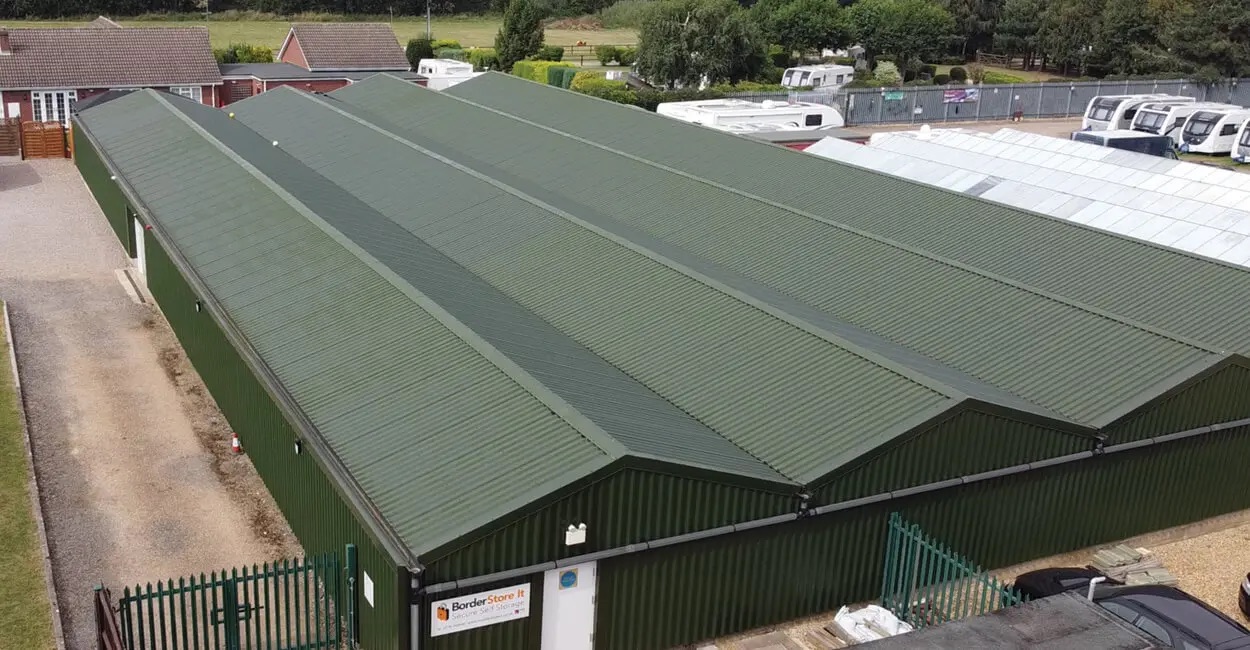

Cladco box profile roofing sheets come in two profiles: 32/1000 and 34/1000. Both of these profiles are manufactured with flat central troughs and have a recommended minimum pitch angle of 4° (a ratio of less than 1:12). The shallow slope makes for more efficient water run-off for low-lying roofs, making these profiles versatile for many applications.
Standing seam roofing - 6° or above
Our 30/500 Standing seam roof sheets create a sleek, modern architectural look thanks to their concealed-fixing design. Manufactured from SSAB galvanised Swedish steel with a premium GreenCoat® Pural BT coating, they require a minimum pitch angle of 6° to ensure water runoff and structural integrity.
Corrugated roofing - 10° or above
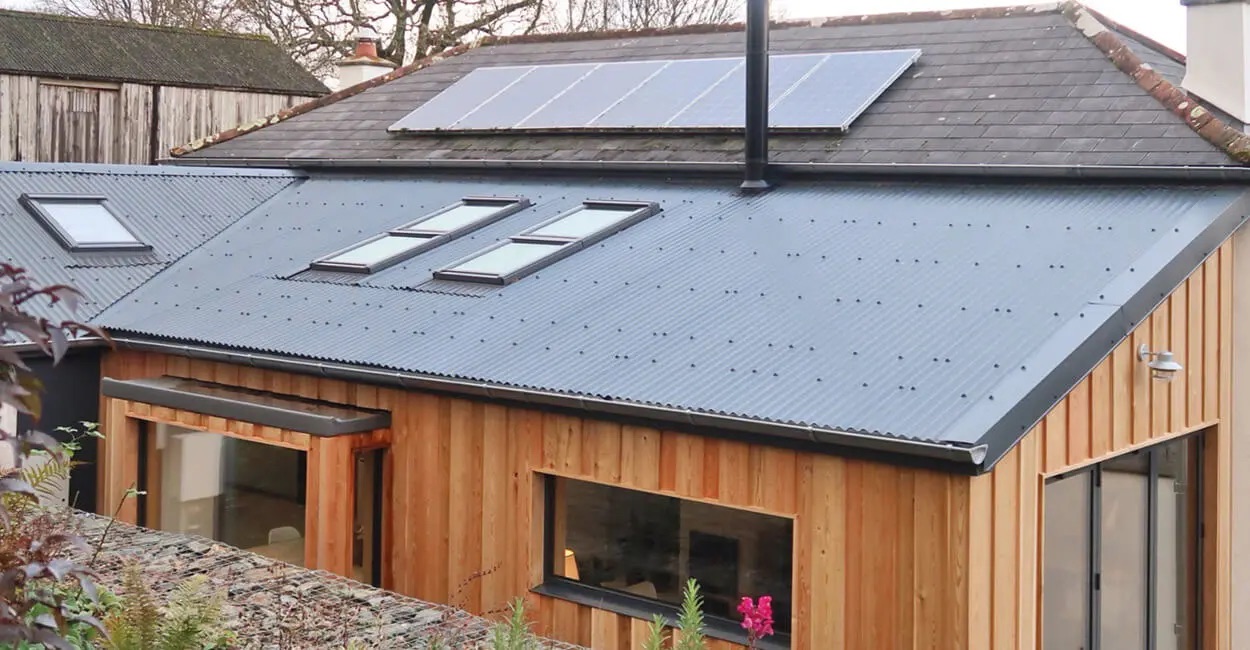

Our 13/3 corrugated roofing sheets feature a 'wavey' aesthetic, which is popular for side cladding and roofing applications. This profile is suited for multiple applications, from shed roofs to lean-tos and larger agricultural buildings. With a minimum pitch angle of 10°, the roof slope needs to be carefully considered so as not to affect the structural integrity of the sheet. On top of this, if installed onto a flat roof, water runoff is also reduced, with objects potentially becoming blocked in the corrugations of the sheet.
Tile form roofing - 12° or above
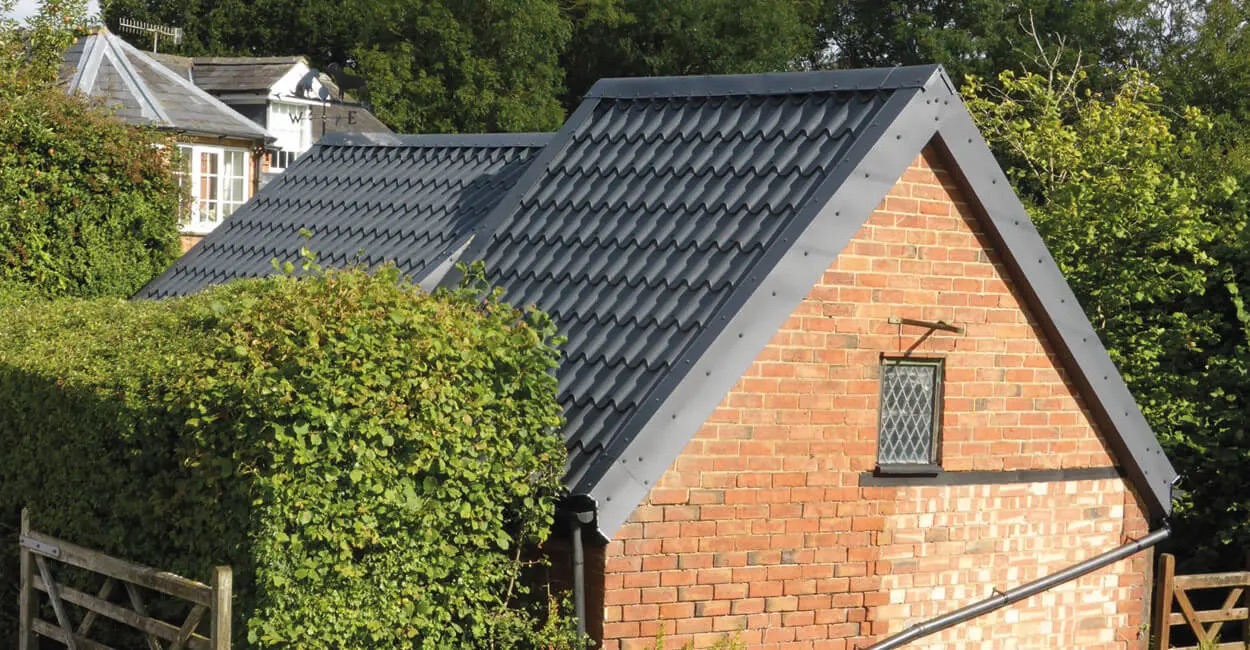

Tile form roofing sheets are designed to replicate the appearance of traditional pantiles while offering the strength of steel. Each sheet provides a coverage width of 1000mm and must be installed on a roof pitch of 12°. The steeper pitch helps maintain structural integrity while also improving water drainage and debris runoff across the roof.
Already know the pitch of your roof? Try our free online roofing calculator for a no obligation quote, or speak to our friendly Sales Team on 01837 659901.
Last Updated: November 25, 2025
Please note all information is correct at the time of writing. However, we encourage you to do your own research to ensure it remains accurate and relevant to your needs.


